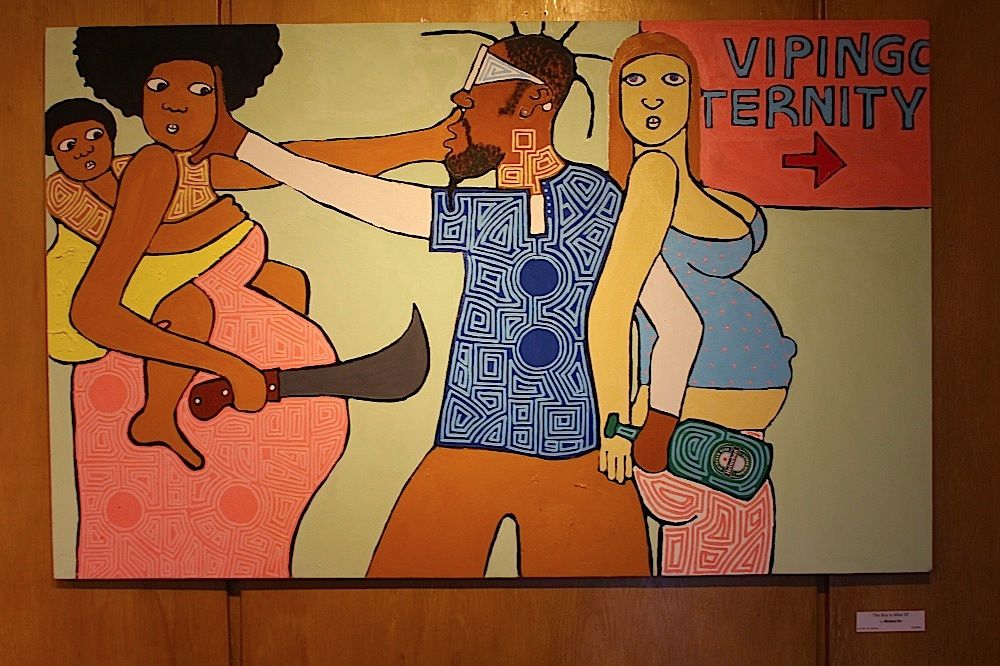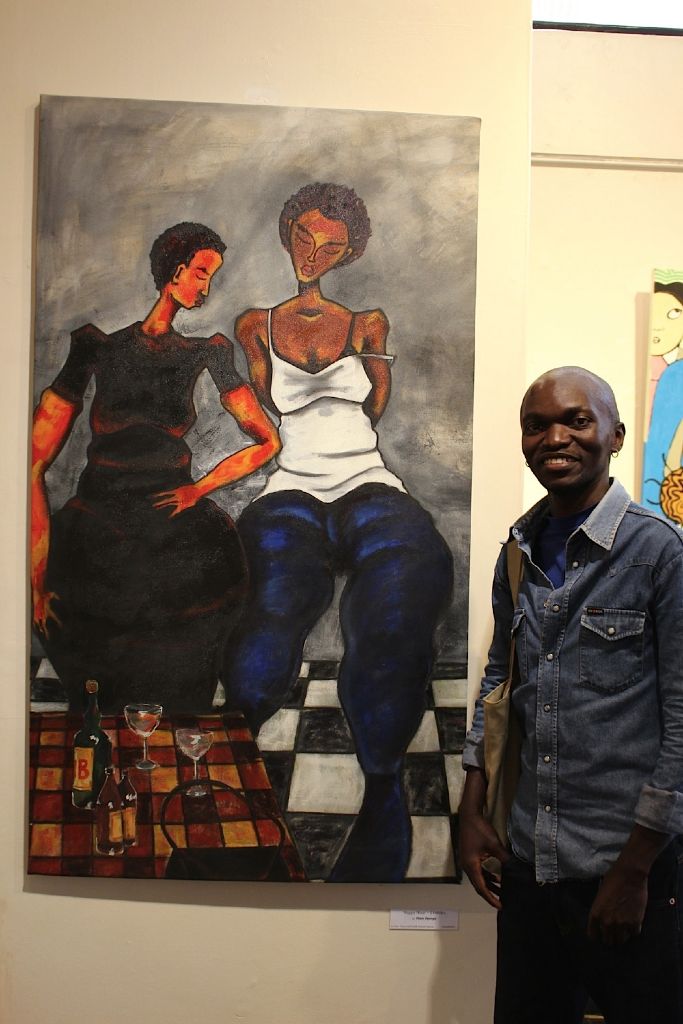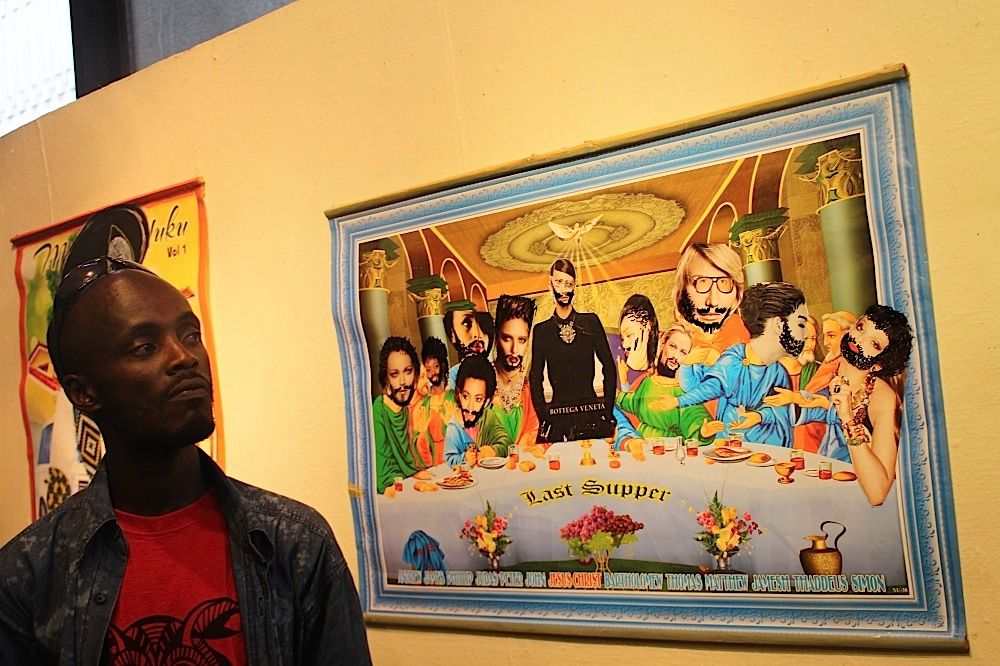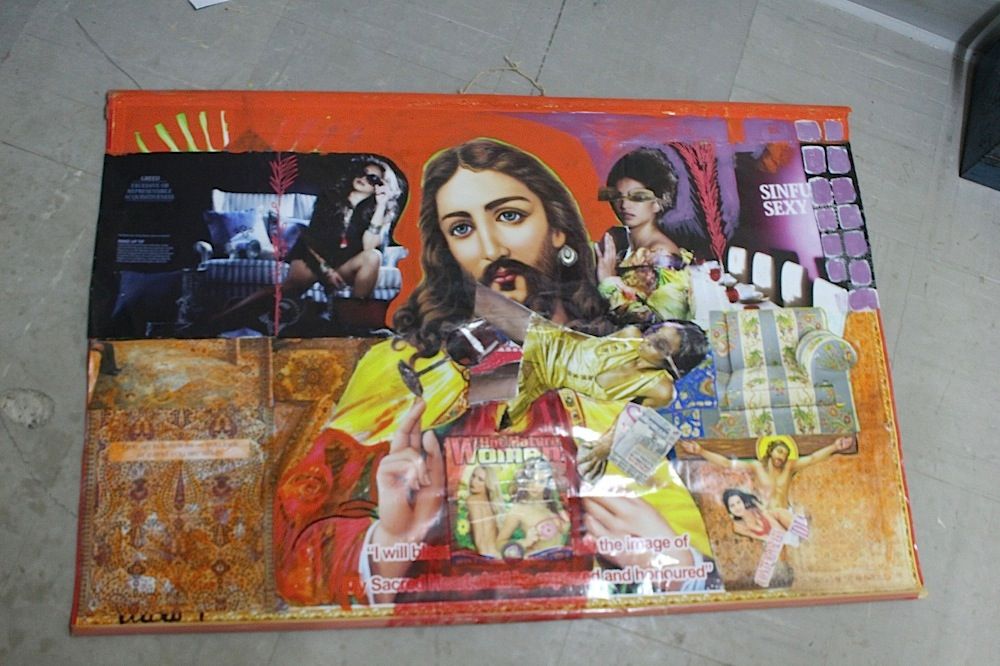Boniface Maina's art was displayed at Brush tu's Open House in December, 2020
BY Margaretta wa Gacheru (published December 25, 2020)
Having an
Open House implies being so transparent and welcoming that you are happy to
invite any and everyone into your home. Even during a pandemic, the Brush tu
Art Collective was willing to declare their open invitation on Instagram to
come and see some of the latest artwork Brush tu artists have conceived, mostly
since March when the COVID shutdowns first hit.
For
instance, Boniface Maina, one of the co-founders of the Collective (with
Michael Musyoka and David Thuku) just recently had a solo exhibition at Circle
Art Gallery (where masks and social distancing were imperatives). Yet he
presented four of his post-exhibition paintings, each one placing Maina’s
avatar in spaces where COVID hasn’t reached and life is relaxed. His only concern
is that two of his paintings are entitled ‘Fantasy’, yet most Kenyans know the
pandemic is neither a fantasy nor a hoax. So those paintings seem almost otherworldly
since the avatar looks oblivious to the viral threat.
Boni Maina's art at Brush Tu Open House
Among the
other Brush tu artists who have been painting up a storm since the shutdowns
kept them at home is Sebawali Sio who has brought several of her latest
glass-on-glass paintings to display during the group’s Open House weekend.
“But we’re
likely to keep the exhibition open for another week or two since many people
have said they want to see our work but don’t want to be around crowds,”
Sebawali tells Business Daily. That’s a good sign since there are lots of red
‘sold’ stickers on the art, but still, there are a few visible price tags,
meaning works are still there to be sold.
Peteros Ndunde is among those artists whose paintings have red stickers, while Maina also had a few. (The rest of the reds are scattered all around the studio.) Fortunately, Peteros promised interested parties that he would bring more of his new paintings early next week to replace those already sold.
But while
the new owners of Peteros’ works agreed to leave their art at the studio for
others to see the subtle new developments in his style, Lincoln Mwangi’s
clients had other plans. They bought nearly all the young painter’s paintings shorter
after the doors opened for the artists’ Jamhuri weekend event. But they were
also quick to lift Lincoln’s artworks off the wall and quietly disappeared,
leaving just one of his paintings and a long bare wall. The artist wasn’t disappointed
about the sales but he was already hearing from unhappy shoppers who wanted to see
and potentially buy more of his art.
One of Brush
tu regulars who did not disappoint was Abdul Kiprop. He had a whole wall-like panel
filled with his COVIS Mask prints made with the printing press that the artist
made from scratch. Having come to Brush tu with the intention of becoming a
painter, Abdul attended several print workshops given through Brush tu by master
printers like Peterson Kamwathi and Thom Ogonga. He was wholly hooked on the
art of printmaking after that. But as he was taught on other people’s presses,
he realized he had no choice but to make his own, which he did! Now it’s
available for use by all the Brush tu artists and friends who want to
experiment with printing.
That air of
openness and sharing is the ethos that has been a part of Brush tu’s appeal
from the outset. It is also one reason the group has had so many interns arriving
from various art institutions, both local and European. Most recently,
photographer and art blogger Emmaus Kimani took part in a German cultural
exchange program that took him to Berlin initially for three months. “But then,
when the pandemic hit, I had to remain in Germany another four months,” says
Emmaus who also had a chance to visit Hamburg where he met up with fellow
Kenyan artist, Nicholas ‘Nicomambo’ Odhiambo who is currently studying fine art
at the university there.
Emmaus also
had a display table set up at Brush tu where the public could view an abundance
of his photographs printed as post cards and computer mouse pads (but equally
frameable). This intrepid camera man takes photos wherever he goes, both
locally and overseas. In Germany, he was big on shooting skyscapes and other
artful images.
Other Brush
tu artists who have works on display included sculptor Boniface Kimani, Munene
Kariuki, newcomer Husna Nyathira Ismail, Waweru Gichuhi and Moira Bushkimani
whose paper-cut paintings were in high demand even without price tags on them.
BY
Margaretta wa Gacheru (published December 25, 2020)
Having an
Open House implies being so transparent and welcoming that you are happy to
invite any and everyone into your home. Even during a pandemic, the Brush tu
Art Collective was willing to declare their open invitation on Instagram to
come and see some of the latest artwork Brush tu artists have conceived, mostly
since March when the COVID shutdowns first hit.
For
instance, Boniface Maina, one of the co-founders of the Collective (with
Michael Musyoka and David Thuku) just recently had a solo exhibition at Circle
Art Gallery (where masks and social distancing were imperatives). Yet he
presented four of his post-exhibition paintings, each one placing Maina’s
avatar in spaces where COVID hasn’t reached and life is relaxed. His only concern
is that two of his paintings are entitled ‘Fantasy’, yet most Kenyans know the
pandemic is neither a fantasy nor a hoax. So those paintings seem almost otherworldly
since the avatar looks oblivious to the viral threat.
Among the
other Brush tu artists who have been painting up a storm since the shutdowns
kept them at home is Sebawali Sio who has brought several of her latest
glass-on-glass paintings to display during the group’s Open House weekend.
“But we’re
likely to keep the exhibition open for another week or two since many people
have said they want to see our work but don’t want to be around crowds,”
Sebawali tells Business Daily. That’s a good sign since there are lots of red
‘sold’ stickers on the art, but still, there are a few visible price tags,
meaning works are still there to be sold.
Peteros
Ndunde is among those artists whose paintings have red stickers, while Maina
also had a few. (The rest of the reds are scattered all around the studio.) Fortunately,
Peteros promised interested parties that he would bring more of his new paintings
early next week to replace those already sold.
But while
the new owners of Peteros’ works agreed to leave their art at the studio for
others to see the subtle new developments in his style, Lincoln Mwangi’s
clients had other plans. They bought nearly all the young painter’s paintings shorter
after the doors opened for the artists’ Jamhuri weekend event. But they were
also quick to lift Lincoln’s artworks off the wall and quietly disappeared,
leaving just one of his paintings and a long bare wall. The artist wasn’t disappointed
about the sales but he was already hearing from unhappy shoppers who wanted to see
and potentially buy more of his art.
One of Brush
tu regulars who did not disappoint was Abdul Kiprop. He had a whole wall-like panel
filled with his COVIS Mask prints made with the printing press that the artist
made from scratch. Having come to Brush tu with the intention of becoming a
painter, Abdul attended several print workshops given through Brush tu by master
printers like Peterson Kamwathi and Thom Ogonga. He was wholly hooked on the
art of printmaking after that. But as he was taught on other people’s presses,
he realized he had no choice but to make his own, which he did! Now it’s
available for use by all the Brush tu artists and friends who want to
experiment with printing.
That air of
openness and sharing is the ethos that has been a part of Brush tu’s appeal
from the outset. It is also one reason the group has had so many interns arriving
from various art institutions, both local and European. Most recently,
photographer and art blogger Emmaus Kimani took part in a German cultural
exchange program that took him to Berlin initially for three months. “But then,
when the pandemic hit, I had to remain in Germany another four months,” says
Emmaus who also had a chance to visit Hamburg where he met up with fellow
Kenyan artist, Nicholas ‘Nicomambo’ Odhiambo who is currently studying fine art
at the university there.
Emmaus also
had a display table set up at Brush tu where the public could view an abundance
of his photographs printed as post cards and computer mouse pads (but equally
frameable). This intrepid camera man takes photos wherever he goes, both
locally and overseas. In Germany, he was big on shooting skyscapes and other
artful images.
Other Brush
tu artists who have works on display included sculptor Boniface Kimani, Munene
Kariuki, newcomer Husna Nyathira Ismail, Waweru Gichuhi and Moira Bushkimani
whose paper-cut paintings were in high demand even without price tags on them.



















